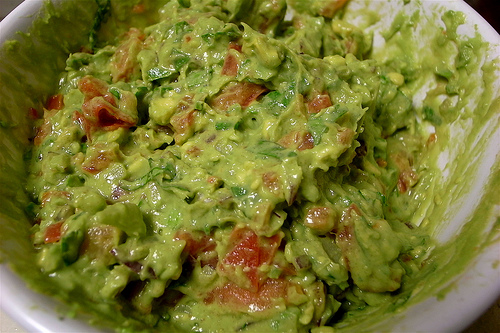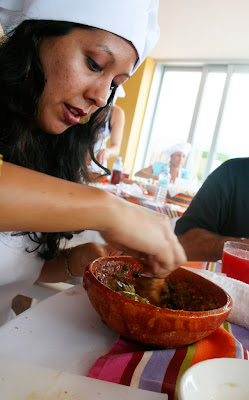The cocer-cocinar dilemma
Broadly speaking, both words mean “to cook” in English but scratch the surface and you will discover that there is quite a subtle yet well-defined difference between them. To understand this difference, we need to first understand what cooking generally involves. Now regardless of whether you can cook, you know what goes on in your kitchen.
 |
| Cocinar or cocer? Photo credit: Neeta Lind licensed CC BY 2.0 |
However, cooking in English also stands for something more specific. The act of processing a food over heat, e.g., boiling, frying, roasting, etc. This set of activities have a slightly different representation in Spanish – cocer. You can see cocer as a subset of cocinar. Look at it this way: Cocinar is the whole gamut. All activities involved in it can be categorized under preparar (preparing the food, e.g., chopping, marinating, peeling, etc.) and cocer (cooking over fire, e.g., boiling, steaming, frying, baking, etc.).
Interestingly, etymology ensures you never forget these words ever again. Turns out, these words are related to the English “cook” sharing a common Latin ancestor, coquō. Never mind how the /k/ sound morphed into /s/; some evolutionary forces at work here.
By the way, here’s a fun fact: In Dominican Republic, cocina is a slang for the back seats in a guagua (a local name for “bus” in DR).
Some more kitchen verbs
 |
| Homemade guacamole from a Mexican kitchen Photo credit: Naotake Murayama licensed CC BY 2.0 |
- agregar (to add) – Does this not sound eerily similar to “aggregate”? Well, that’s because it is. They obviously share a common Latin ancestry. This word is used whenever you are adding an ingredient to your mess while preparing it for cooking.
- ahumar (to smoke) – No, this is not about cigarettes. This is what you do to, say, salmons. Cooking with smoke. But you guessed it right, ahumar does come from the same source as fumar (to smoke, e.g., a cigarette) and the common ancestor here is fumō, again Latin. This word also gave us the English word, “fume.”
- batir (to beat) – This one’s a no-brainer; the two words sound close enough to stay in your head without much trouble.
- capear (to cover) – You can easily relate to this word when you realize that “to cap” also means “to cover” in English. But capear is not used in every context. This word specifically refers to covering something in, say, butter for the purpose of frying.
- cubrir (to cover) – Now, this is the word you use when speaking of physically covering your food with an actual lid or cover. Also note how this word rings similar to its English counterpart, “cover,” and it should be a cakewalk to recall.
- napar (to cover) – Again! How many words do they have for covering in Spanish! Don’t worry, it’s all about the context. In this case, we are completely bathing a dish in a sauce or something similar so that the latter completely covers not just the dish but also the plate! Drooling already? Think of a black forest pastry completely drowned in hot chocolate and that’s what napar implies. So, while capear is while cooking, napar is while serving. Not sure where this word comes from but you can visualize the hot chocolate cover as having no parallel to help yourself remember and recall it effortlessly.
- cortar (to cut up) – Again, the reason cortar sounds so similar to “cut” is their common Latin ancestry. Think of it as an action that renders something shorter or smaller.
- trocear (to cut up) – This one doesn’t seem to be any different from cortar except that it obviously has a different etymology.
- desvenar (to remove the veins as in from chillies) – Another no-brainer. The prefix, des-, lends the meaning of removing something while venar comes from véna which, in turn, comes from the Latin vēna that gave us the English “vein.” Think of desvenar as “de-vein.”
- enharinar (to coat/sprinkle with a thin layer of flour) – In English, when you coat something with a balm-like thingy, it’s embalming. Similarly, in Spanish, when you coat something with harina (flour), it’s enharinar.
- quemar (to burn) – This one has an interesting history. Quemar is a direct descendant of the Latin word for burn, cremō. And, it is this Latin word that gave us “cremate” in English. For those of you who don’t know, cremation is the traditional burning up of a dead body at funeral in some cultures.
- flamear (to burn) – This word doesn’t exactly burn your food unless you are reckless enough. Here, you use flame as a show-off by smothering the hot dish in a liquor, such as brandy, and then igniting it to create what’s typically known as, flambé. The flame in this process is used more for its visual effects than to actually burn the food.
- llenar (to fill) – Imagine you are being served mezcal at a Mexican restaurant and the absent-minded server continues to pour to the point where it’s about to spill. What would you do? You’d obviously say, “no,” once you see your cup’s full. Use this imagination to remember that lleno is the Spanish for “full.” It is this word that gives us the verb, llenar.
- rellenar (to stuff) – The prefix, re-, is often added to many Spanish verbs to accentuate the action, giving it a sense of being kind of overdone. It has the same etymology as the similarly-spelled prefix in English but with a slight difference, e.g., frijoles refritos is “well-fried beans” and not “refried beans” as most assume. Similarly, adding the prefix to llenar gives it a sense of “over-filling” or, simply put, “stuffing.” Drool over papas rellenas (stuffed potatoes) if that helps.
- freir (to fry) – Well this one sounds like its English counterpart given their shared origins.
- derretir (to melt, thaw, or liquify) – Imagine yourself as an action-packed, hot-headed bag of testosterone while you’re still young and active. But then you’re going to lose much of this youthful vigor and thaw down as you grow older and retire. This visual mnemonic should be enough to affix this word to your head for a lifetime.
- guisar (to stew) – Though this word has Proto-Germanic roots, just as English does, it would probably be easier to rely on visualization in this case as its etymology is kind of complicated. Think of yourself guised as your favorite superhero, say Spiderman, busy stewing something in the kitchen.
- hervir (to boil) – This one comes from the Latin fervere which gave English the word, “fever.” Heat is the lowest common denominator here.
- sancochar (to parboil) – Though this word means almost the same as hervir, there’s a slight difference. You use hervir when you are actually boiling some liquid, such as water. However, it’s sancochar when you boil some food stuff in that liquid.
- hornear (to bake in an oven) – From the Latin furnus comes the English “furnace” and the Spanish horno. So, naturally whatever you do in an horno (i.e., bake) is hornear.
- machacar (to crush, pulverize, pound, or grind) – Think of a burly macho dude crushing a fistful of walnuts in one effortless twist. Can you relate?
- pelar (to peel) – Both have a common root and hence the similar ring.
- remover (to stir) – If mover is “to move,” adding the prefix, re-, would add a certain overkill to this action; thus, remover means, “to move thoroughly” or, “to stir.”
- mezclar (to mix) – Again, the words sound too similar to warrant any special memory cue.
- salar (to add salt) – Sal is Spanish for “salt,” so, salar naturally becomes the Spanish for adding salt to your food.
- sazonar (to season or garnish) – Again, they sound fairly similar.
- helar (to freeze) – Hielo is the Spanish for “ice” hence the derived verb.
- congelar (to deep-freeze) – This one comes from gelu, the Latin for “ice.” Incidentally, gelu gave us the English word, “congeal,” which means, “to solidify or coagulate by cooling.”
- nevar (to froth egg-white) – Generally, this word means, “to snow,” but in the kitchen it refers to frothing of egg-white given the visual similarity between the latter and the physical snow.
- untar (to spread) – What happens if you untie a polyethylene bag of yoghurt? It spreads all over. rings a bell?
 |
| Flamear or quemar? Photo credit: Jenene Chesbrough licensed CC BY 2.0 |
 |
| Papa rellena Photo credit: Robert Luna licensed CC BY 2.0 |
 |
| Machacar en un molcajete Photo credit: ccharmon licensed CC BY-ND 2.0 |
That should be enough for now. These were some of the most commonly verbs used in the kitchen and should have you covered for most culinary situations. The same word-association tricks that we used here can also be used in acquiring other words, such as these 13 Spanish names of kitchen objects.



.png)
I'm truly enjoying the design and layout of your blog. It's a very easy on the eyes which makes it much
ReplyDeletemore enjoyable for me to come here and visit more often.
Did you hire out a developer to create your theme?
Superb work!
Visit my web site - trodosuizacom